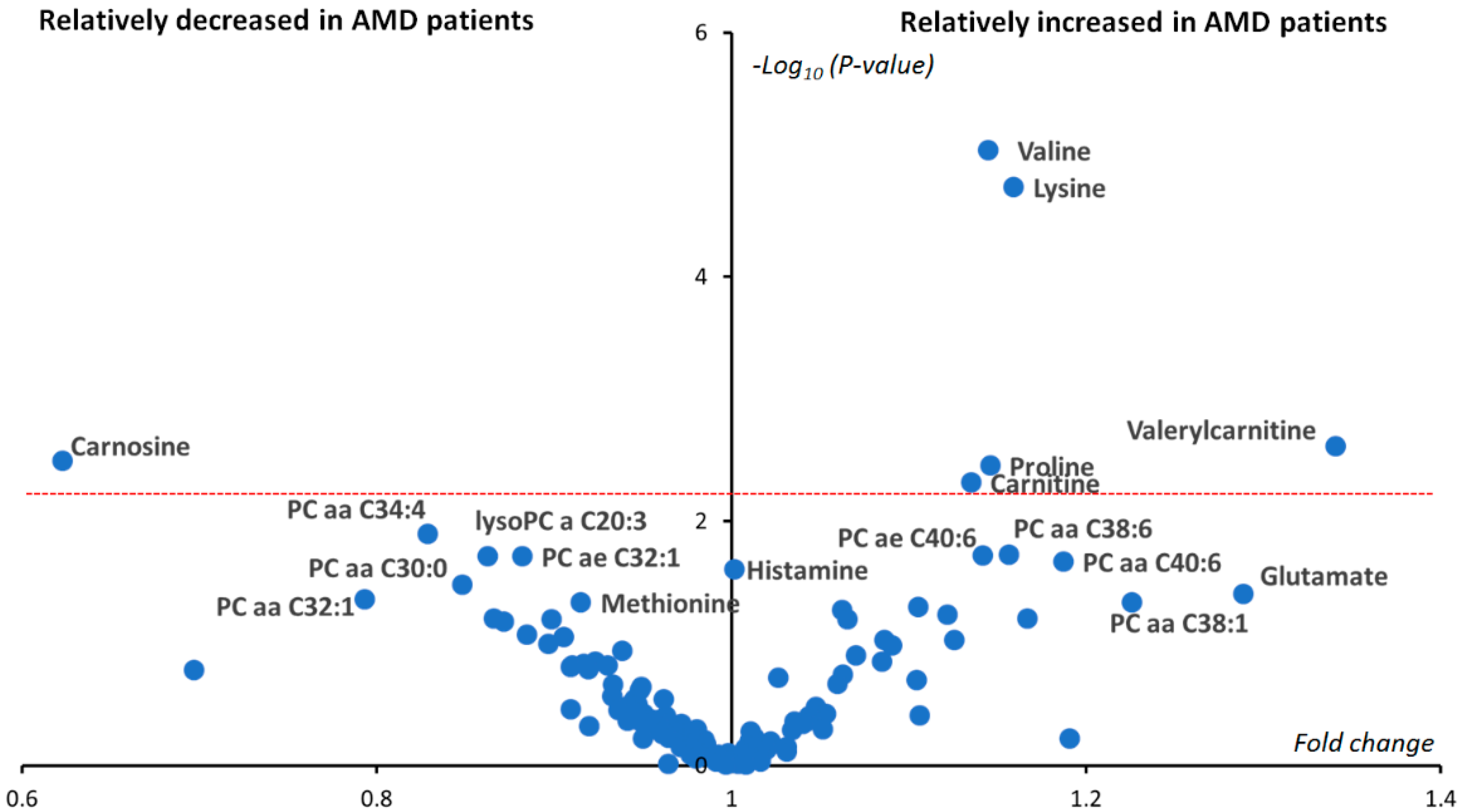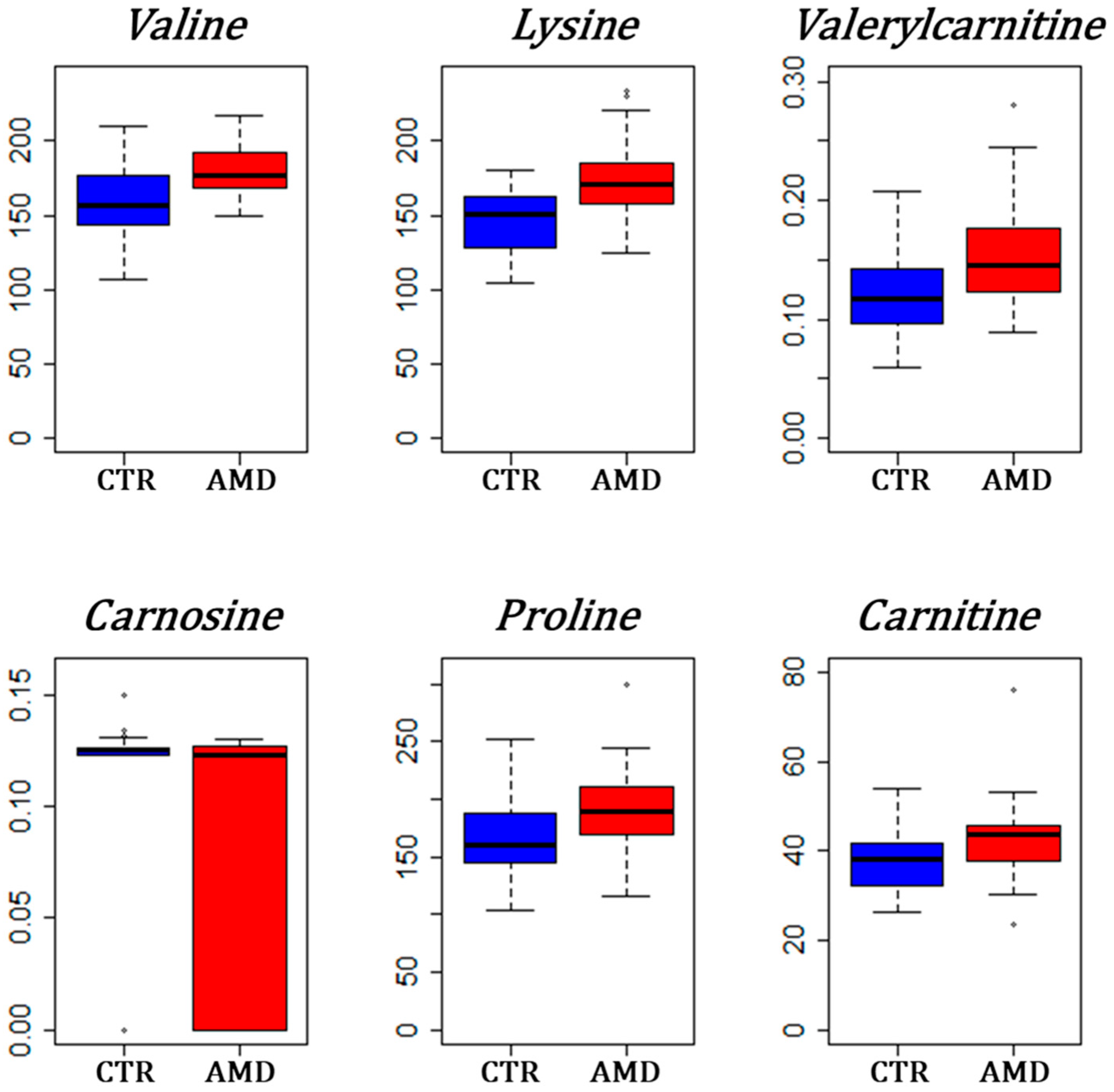A Plasma Metabolomic Profiling of Exudative Age-Related Macular Degeneration Showing Carnosine and Mitochondrial Deficiencies
Abstract
1. Introduction
2. Experimental Section
2.1. Study Participants
2.2. Samples Collection
2.3. Metabolomics Analysis
2.4. Statistical Analysis
3. Results
3.1. Clinical Features of AMD Patients and Controls
3.2. Metabolomic Analysis
4. Discussion
5. Conclusions
Supplementary Materials
Author Contributions
Funding
Acknowledgments
Conflicts of Interest
References
- Bourne, R.R.; Jonas, J.B.; Flaxman, S.R. Prevalence and causes of vision loss in high-income countries and in Eastern and Central Europe: 1990–2010. Br. J. Ophthalmol. 2014, 98, 629–638. [Google Scholar] [CrossRef]
- Klein, R.; Chou, C.F.; Klein, B.E.; Zhang, X.; Meuer, S.M.; Saaddine, J.B. Prevalence of age-related macular degeneration in the US population. Arch. Ophthalmol. 2011, 129, 75–80. [Google Scholar] [CrossRef]
- Solomon, S.D.; Lindsley, K.; Vedula, S.S.; Krzystolik, M.G.; Hawkins, B.S. Anti-vascular endothelial growth factor for neovascular age-related macular degeneration. Cochrane Database Syst. Rev. 2019, 3, CD005139. [Google Scholar] [CrossRef] [PubMed]
- Gehrs, K.M.; Anderson, D.H.; Johnson, L.V.; Hageman, G.S. Age-related macular degeneration—Emerging pathogenetic and therapeutic concepts. Ann. Med. 2006, 38, 450–471. [Google Scholar] [CrossRef] [PubMed]
- Pinazo-Durán, M.D.; Gómez-Ulla, F.; Arias, L.; Araiz, J.; Casaroli-Marano, R.; Gallego-Pinazo, R.; García-Medina, J.J.; López-Gálvez, M.I.; Manzanas, L.; Salas, A.; et al. Do nutritional supplements have a role in age macular degeneration prevention? J. Ophthalmol. 2014, 2014, 901686. [Google Scholar] [CrossRef] [PubMed]
- Brown, C.N.; Green, B.D.; Thompson, R.B.; den Hollander, A.I.; Lengyel, I. EYE-RISK consortium. Metabolomics and Age-Related Macular Degeneration. Metabolites 2018, 9, 4. [Google Scholar] [CrossRef]
- Osborn, M.P.; Park, Y.; Parks, M.B.; Burgess, L.G.; Uppal, K.; Lee, K.; Jones, D.P.; Brantley, M.A., Jr. Metabolome-wide association study of neovascular age-related macular degeneration. PLoS ONE 2013, 8, e72737. [Google Scholar] [CrossRef]
- Luo, D.; Deng, T.; Yuan, W.; Deng, H.; Jin, M. Plasma metabolomic study in Chinese patients with wet age-related macular degeneration. BMC Ophthalmol. 2017, 17, 165. [Google Scholar] [CrossRef]
- Laíns, I.; Duarte, D.; Barros, A.S.; Martins, A.S.; Gil, J.; Miller, J.B.; Marques, M.; Mesquita, T.; Kim, I.K.; Cachulo, M.D.L.; et al. Human plasma metabolomics in age-related macular degeneration (AMD) using nuclear magnetic resonance spectroscopy. PLoS ONE 2017, 12, e0177749. [Google Scholar] [CrossRef]
- Laíns, I.; Kelly, R.S.; Miller, J.B.; Silva, R.; Vavvas, D.G.; Kim, I.K.; Murta, J.N.; Lasky-Su, J.; Miller, J.W.; Husain, D. Human plasma metabolomics study across all stages of age-related macular degeneration identifies potential lipid biomarkers. Ophthalmology 2018, 125, 245–254. [Google Scholar] [CrossRef]
- Laíns, I.; Chung, W.; Kelly, R.S.; Gil, J.; Marques, M.; Barreto, P.; Murta, J.N.; Kim, I.K.; Vavvas, D.G.; Miller, J.B.; et al. Human plasma metabolomics in age-related macular degeneration: Meta-analysis of two cohorts. Metabolites 2019, 9, 127. [Google Scholar] [CrossRef] [PubMed]
- Kersten, E.; Dammeier, S.; Ajana, S.; Groenewoud, J.M.M.; Codrea, M.; Klose, F.; Lechanteur, Y.T.; Fauser, S.; Ueffing, M.; Delcourt, C.; et al. Metabolomics in serum of patients with non-advanced age-related macular degeneration reveals aberrations in the glutamine pathway. PLoS ONE 2019, 14, e0218457. [Google Scholar] [CrossRef] [PubMed]
- Leruez, S.; Bresson, T.; Chao de la Barca, J.M.; Marill, A.; de Saint Martin, G.; Buisset, A.; Muller, J.; Tessier, L.; Gadras, C.; Verny, C.; et al. A plasma metabolomic signature of the exfoliation syndrome involves amino acids, acyl-carnitines and polyamines. Investig. Ophthalmol. Vis. Sci. 2018, 59, 1025–1032. [Google Scholar] [CrossRef] [PubMed]
- Zhao, B.; Wang, M.; Xu, J.; Li, M.; Yu, Y. Identification of pathogenic genes and upstream regulators in age-related macular degeneration. BMC Ophthalmol. 2017, 17, 102. [Google Scholar] [CrossRef]
- Chao, J.R.; Knight, K.; Engel, A.L.; Jankowski, C.; Wang, Y.; Manson, M.A.; Gu, H.; Djukovic, D.; Raftery, D.; Hurley, J.B.; et al. Human retinal pigment epithelial cells prefer proline as a nutrient and transport metabolic intermediates to the retinal side. J. Biol. Chem. 2017, 292, 12895–12905. [Google Scholar] [CrossRef]
- Yam, M.; Engel, A.L.; Wang, Y.; Zhu, S.; Hauer, A.; Zhang, R.; Lohner, D.; Huang, J.; Dinterman, M.; Zhao, C.; et al. Proline mediates metabolic communication between retinal pigment epithelial cells and the retina. J. Biol. Chem. 2019, 294, 10278–10289. [Google Scholar] [CrossRef]
- Chirco, K.R.; Sohn, E.H.; Stone, E.M.; Tucker, B.A.; Mullins, R.F. Structural and molecular changes in the aging choroid: Implications for age-related macular degeneration. Eye 2017, 31, 10–25. [Google Scholar] [CrossRef]
- Gao, X.R.; Huang, H.; Kim, H. Genome-wide association analyses identify 139 loci associated with macular thickness in the UK Biobank cohort. Hum. Mol. Genet. 2019, 28, 1162–1172. [Google Scholar] [CrossRef]
- Mitchell, S.L.; Uppal, K.; Williamson, S.M.; Liu, K.; Burgess, L.G.; Tran, V.; Umfress, A.C.; Jarrell, K.L.; Bailey, J.N.C.; Agarwal, A.; et al. The Carnitine Shuttle Pathway is Altered in Patients With Neovascular Age-Related Macular Degeneration. Investig. Ophthalmol. Vis. Sci. 2018, 59, 4978–4985. [Google Scholar] [CrossRef]
- Kelley, R.A.; Al-Ubaidi, M.R.; Sinha, T.; Genc, A.M.; Makia, M.S.; Ikelle, L.; Naash, M.I. Ablation of the riboflavin-binding protein retbindin reduces flavin levels and leads to progressive and dose-dependent degeneration of rods and cones. J. Biol. Chem. 2017, 292, 21023–21034. [Google Scholar] [CrossRef]
- Elner, S.G.; Elner, V.M.; Field, M.G.; Park, S.; Heckenlively, J.R.; Petty, H.R. Retinal flavoprotein autofluorescence as a measure of retinal health. Trans. Am. Ophthalmol. Soc. 2008, 106, 215–222. [Google Scholar] [PubMed]
- Reddy, V.P.; Garrett, M.R.; Perry, G.; Smith, M.A. Carnosine: A versatile antioxidant and antiglycating agent. Sci. Aging Knowl. Environ. 2005, 2005, pe12. [Google Scholar] [CrossRef] [PubMed]
- Boldyrev, A.A.; Stvolinsky, S.L.; Fedorova, T.N.; Suslina, Z.A. Carnosine as a natural antioxidant and geroprotector: From molecular mechanisms to clinical trials. Rejuvenation Res. 2010, 13, 156–158. [Google Scholar] [CrossRef] [PubMed]
- Babizhayev, M.A.; Micans, P.; Guiotto, A.; Kasus-Jacobi, A. N-acetylcarnosine lubricant eyedrops possess all-in-one universal antioxidant protective effects of L-carnosine in aqueous and lipid membrane environments, aldehyde scavenging, and transglycation activities inherent to cataracts: A clinical study of the new vision-saving drug N-acetylcarnosine eyedrop therapy in a database population of over 50,500 patients. Am. J. Ther. 2009, 16, 517–533. [Google Scholar] [PubMed]
- Burgess, S.; Davey Smith, G. Mendelian Randomization Implicates High-Density Lipoprotein Cholesterol-Associated Mechanisms in Etiology of Age-Related Macular Degeneration. Ophthalmology 2017, 124, 1165–1174. [Google Scholar] [CrossRef]
- Ferrington, D.A.; Fisher, C.R.; Kowluru, R.A. Mitochondrial Defects Drive Degenerative Retinal Diseases. Trends Mol. Med. 2020, 26, 105–118. [Google Scholar] [CrossRef]
- Macedo, L.W.; Cararo, J.H.; Maravai, S.G.; Gonçalves, C.L.; Oliveira, G.M.; Kist, L.W.; Guerra Martinez, C.; Kurtenbach, E.; Bogo, M.R.; Hipkiss, A.R.; et al. Acute Carnosine Administration Increases Respiratory Chain Complexes and Citric Acid Cycle Enzyme Activities in Cerebral Cortex of Young Rats. Mol. Neurobiol. 2016, 53, 5582–5590. [Google Scholar] [CrossRef]



| AMD | Controls | p-Values | |
|---|---|---|---|
| N = 40 | N = 40 | ||
| Demographic data and comorbidities | |||
| Mean age (years) | 81.1 | 81.8 | 0.62 |
| Females (%) | 61 | 59 | 0.86 |
| Mean BMI (kg/m2) | 25.8 | 25.5 | 0.76 |
| Thyroid disease (%) | 6 (14.6%) | 6 (14.6%) | 1 |
| Diabetes (%) | 1 (2.44%) | 0 (0%) | 1 |
| Hypertension (%) | 24 (58.6%) | 22 (53.7%) | 0.72 |
| Dyslipidemia (%) | 10 (24.4%) | 8 (19.5%) | 0.35 |
| Systemic medications | |||
| Antihypertensives (%) | 23 (56.1%) | 21 (51.2%) | 0.66 |
| Lipid-lowering medications (%) | 12 (29.3%) | 8 (19.5%) | 0.35 |
| Antiplatelet treatment (%) | 7 (17.1%) | 9 (22.0%) | 0.57 |
| Insulin (%) | 0 (0%) | 0 (0%) | 1 |
| Oral diabetes medications (%) | 1 (2.44%) | 0 (0%) | 1 |
| Corticosteroids (%) | 1 (2.44%) | 0 (0%) | 1 |
| Thyroid hormones (%) | 6 (14.6%) | 7 (17.1%) | 0.76 |
| Estrogens (%) | 0 (0%) | 0 (0%) | 1 |
| Vitamin D (%) | 4 (9.76%) | 0 (0%) | 0.12 |
| Ophthalmological features and AMD management | |||
| Mean visual acuity (logMAR) | 0.635 | 0.136 | <0.0001 * |
| Mean IOP (mmHg) | 14.2 | 15.5 | 0.1 |
| Mean CMT (µm) at the initial stage of the disease | 332.5 | 263.6 | <0.0001 * |
| Mean CMT (µm) at inclusion | 236.5 | 263.6 | 0.024 * |
| Cataract (%) | 32.5 | 27.5 | 0.808 |
| AMD Management | |||
| -Anti-VEGF intravitreal injections (%) | 40 (100%) | — | — |
| -Nutritional supplementations: | |||
| -Vitamin E | 6 (14.6%) | 0 (0%) | 0.023 * |
| -Vitamin C | 6 (14.6%) | 0 (0%) | 0.023 * |
| -Vitamin B3, B6, B2, B1, B9, D3, B12 | 1 (2.44%) | 0 (0%) | 1 |
| -Zinc | 6 (14.6%) | 0 (0%) | 0.023 * |
| -Copper | 2 (4.88%) | 0 (0%) | 0.49 |
| -Selenium | 1 (2.44%) | 0 (0%) | 1 |
| -Manganese | 1 (2.44%) | 0 (0%) | 1 |
| -Omega 3 | 6 (14.6%) | 0 (0%) | 0.023 * |
| -DHA | 6 (14.6%) | 0 (0%) | 0.023 * |
| -EPA | 2 (4.88%) | 0 (0%) | 0.49 |
| -DPA | 2 (4.88%) | 0 (0%) | 0.49 |
| -Resveratrol | 1 (2.44%) | 0 (0%) | 1 |
| -Lutein | 6 (14.6%) | 0 (0%) | 0.023 * |
| -Zeaxanthin | 6 (14.6%) | 0 (0%) | 0.023 * |
© 2020 by the authors. Licensee MDPI, Basel, Switzerland. This article is an open access article distributed under the terms and conditions of the Creative Commons Attribution (CC BY) license (http://creativecommons.org/licenses/by/4.0/).
Share and Cite
Chao de la Barca, J.M.; Rondet-Courbis, B.; Ferré, M.; Muller, J.; Buisset, A.; Leruez, S.; Plubeau, G.; Macé, T.; Moureauzeau, L.; Chupin, S.; et al. A Plasma Metabolomic Profiling of Exudative Age-Related Macular Degeneration Showing Carnosine and Mitochondrial Deficiencies. J. Clin. Med. 2020, 9, 631. https://doi.org/10.3390/jcm9030631
Chao de la Barca JM, Rondet-Courbis B, Ferré M, Muller J, Buisset A, Leruez S, Plubeau G, Macé T, Moureauzeau L, Chupin S, et al. A Plasma Metabolomic Profiling of Exudative Age-Related Macular Degeneration Showing Carnosine and Mitochondrial Deficiencies. Journal of Clinical Medicine. 2020; 9(3):631. https://doi.org/10.3390/jcm9030631
Chicago/Turabian StyleChao de la Barca, Juan M., Barnabé Rondet-Courbis, Marc Ferré, Jeanne Muller, Adrien Buisset, Stéphanie Leruez, Guillaume Plubeau, Thibaut Macé, Laurie Moureauzeau, Stéphanie Chupin, and et al. 2020. "A Plasma Metabolomic Profiling of Exudative Age-Related Macular Degeneration Showing Carnosine and Mitochondrial Deficiencies" Journal of Clinical Medicine 9, no. 3: 631. https://doi.org/10.3390/jcm9030631
APA StyleChao de la Barca, J. M., Rondet-Courbis, B., Ferré, M., Muller, J., Buisset, A., Leruez, S., Plubeau, G., Macé, T., Moureauzeau, L., Chupin, S., Tessier, L., Blanchet, O., Lenaers, G., Procaccio, V., Mirebeau-Prunier, D., Simard, G., Gohier, P., Miléa, D., & Reynier, P. (2020). A Plasma Metabolomic Profiling of Exudative Age-Related Macular Degeneration Showing Carnosine and Mitochondrial Deficiencies. Journal of Clinical Medicine, 9(3), 631. https://doi.org/10.3390/jcm9030631





